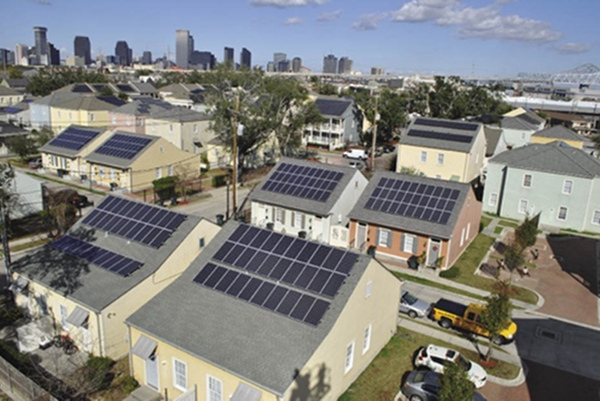Solar power in New Orleans? Yeah, you right. The River Garden Apartments, a mixed-income development covering eight blocks and around a square mile, is currently the largest solar neighborhood in the southeastern US, and the largest solar project in the state of Louisiana.
Once upon a time, the St. Thomas Housing Project was a down-at-the-heel, low-income housing project, known for its high crime rate. But then along came Hurricane Katrina, which hit this area hard. In building back, CleanTechnica reports that this area became the focus of several government agencies working to revitalize it through sustainable and renewable technologies. Now, running a 420 kilowatt-capacity solar photovoltaic system across their rooftops, residents of the River Garden Apartments pay just $0.10 per kilowatt-hour for electricity, saving around $50 a month on utility bills.

In covering the story, Kathleen Zipp of Solar Power World noted that the installation of PV systems on multiple roofs — each with a specific configuration and mounting angle — posed a challenge for the Solar Edge, the designer on this project. In meeting this challenge, SolarEdge relied on its power optimization system to harvest sun from as much of the available roof space as possible, even in areas with partial shading or obstructions.
The system SolarEdge used here allows for those many rooftop arrays to be monitored in real-time via built-in performance data gathered at the module level. This way, underperforming or faulty modules can easily be pinpointed and replaced as needed, with a minimum of both detective work and downtime. In fact, this monitoring system sends automatic web-based alerts to technicians, allowing for adjustments to be made quickly and easily, increasing the overall efficiency of the system.
Because damaged arrays can potentially start arc faults and fires, the system also makes use of a ‘SafeDC’ mechanism to increase its safety. These kinds of precautions are especially important in hurricane-prone areas like New Orleans, where flying debris can easily damage modules and other exposed solar tech.
“We overcame many challenging issues, specifically installing modules on multiple roofs and different angles, in a safe manner and with reduced maintenance costs,” says Micah Galy of Pontchartrain Mechanical Company, which handled installation. He goes on to note that this revitalized community is now able to sustain itself with reliable energy, and will be able to stabilize its energy costs for the long term in a clean and sustainable way.